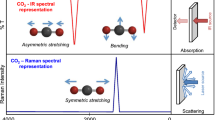Summary
The Raman spectra of cinnamyl alcohol and cinnamyl acetate are re-investigated and their frequencies compared with those of ethyl cinnamate. A great similarity between the spectra of all these substances is observed. The higher C=C and C=O frequencies in cinnamyl acetate and allyl acetate as compared with ethyl cinnamate and ethyl acrylate is explained as due to the existence of resonance in the latter. It is pointed out that when comparisons are effected carefully the C=C and C=O bonds mutually weaken each other when they exist in conjugation.
Similar content being viewed by others
References
Murty and SeshadriProc. Ind. Acad. Sci., 1939,10, 307.
—, 1940,11, 32.
HibbenChem. Rev., 1936,18, 45.
Kohlrausch and SkrabalWien, Ber., 146, 377;Mh. Chem., 1937,70, 377.
PiauxTheses, Paris, 1935.
Gredy, C. R.Acad. Sci., Paris, 1936,202, 322, 644.
Author information
Authors and Affiliations
Rights and permissions
About this article
Cite this article
Murty, G.V.L.N., Seshadri, T.R. Raman effect and chemical constitution. Proc. Indian Acad. Sci. 11, 424–428 (1940). https://doi.org/10.1007/BF03046008
Received:
Issue Date:
DOI: https://doi.org/10.1007/BF03046008




